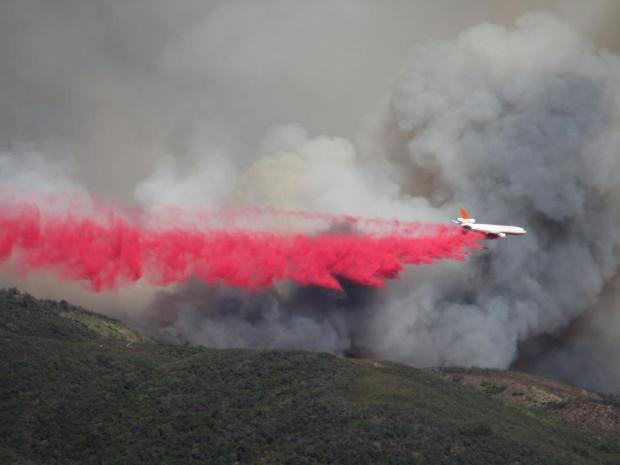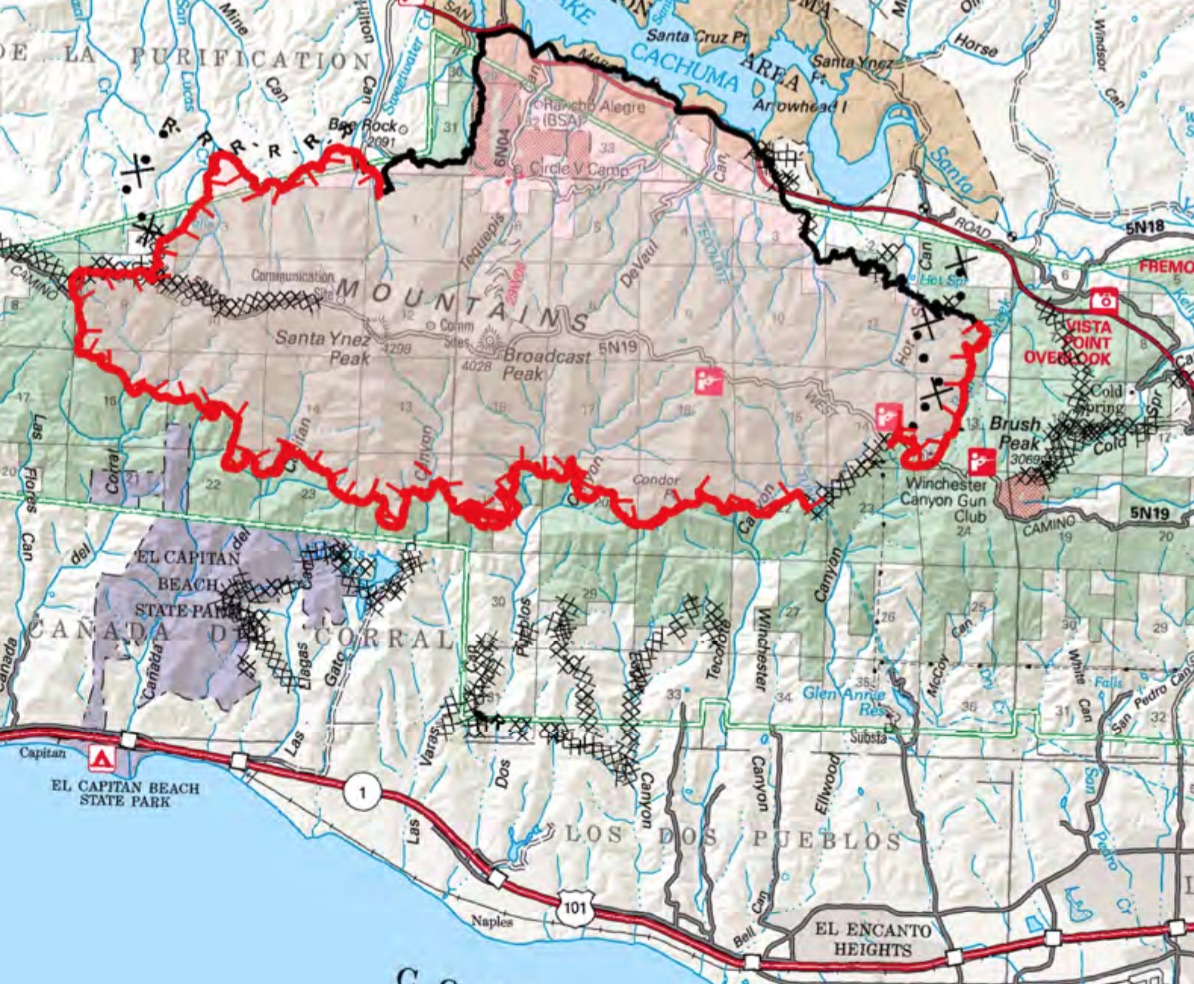Whittier Fire Grows Modestly Saturday Night
Sundowner Winds a Nonevent

Even before 7 a.m. this Sunday morning, there was a hot, sheer intensity to the sunlight breaking over the firefighting base camp at Dos Pueblo High School. For firefighters getting ready to battle the Whittier Fire — now entering its ninth day — that dry, scorching heat will be the big story this Sunday. Backcountry temperatures are expected to hit triple digits, and the relative humidity is less than 10 percent. The key challenge will be containing a growing bubble of fire on the northwestern flank of the fire that wants to push farther to the west and to the north. But the good news at the Sunday morning fire briefing — held amid a growing pop-up city of tents, porta-potties, and fire trucks of every color and jurisdiction for as far as the eye can see — is that the sundowner winds predicted for Saturday night did not arrive with the full vengeance with which they were expected.
The feared downslope winds were not as strong as weather forecasts indicated they’d be, and when they collided with the marine layer — at about 800 feet — they bounced off the surface of the cooler air like rocks skipping off water. For downslope urban dwellers calibrating the fire for the appropriate freak-out response factor, Saturday night’s sundowner no-show was the second such bullet dodged. The night before, the same thing had happened. But even so, the fire managed to grow by 3,300 acres on Friday night. By sharp contrast, the fire grew far more modestly Saturday night, expanding its size by only 400 acres. That brings the total size to about 18,000 acres with containment at 36 percent.

For the incident commanders leading the early morning briefing, Saturday was a good night. Better yet, they noted, no sundowner winds are predicted for the next several days. Better yet, some of the fire’s front slope has already burned and then stopped. If and when it ever comes down the mountain, it will lack the advantage of a running start. Then it will encounter Goleta’s green belt of orchards and fields that acts as buffer between the forest and urban civilization. Lastly, the fuel moisture downslope is considerably higher than in the backcountry. That too is expected to retard the rate of advancement, should Whittier make a serious push toward the populated areas.
Of more concern is keeping the fire hemmed in on its eastern and western flanks, and to that end, the full complement of six air tankers, 16 helicopters, 18 dozers, 145 engines, four masticators, and thousands of chain saws will be focused. Much of the brush on the fire’s eastern edge hasn’t burned for 61 years; brush there is tall, thick, and hard to clear. Some have trunks as thick as oaks.
Temperatures are expected to hit 102 in the backcountry today with gusts of 15 miles an hour and sustained winds of 4-7 miles an hour. Along the ridges, however, the winds are expected to hit 13 miles an hour. With full sun exposure predicted, firefighters were warned to take precautions against heat exhaustion and dehydration. Red Bull and Monster Energy, they were told, do not cut it; water and Gatorade do. Those working on the front country were cautioned to tread lightly when cutting firebreak lines across creek beds; they may be home to endangered species.
Incident Commander Mark von Tillow of the U.S. Forest Service reflected on Sunday being day 9 of the Whittier Fire and suggested those assembled check out a documentary movie made about Santa Barbara’s Refugio Fire of 1955. Much of the Whittier Fire, he noted, takes place in the footprints of that blaze. “There were 2,500 people on a 5,500-acre fire,” von Tillow said. “They were done in nine days.” After a brief pause, he added, “We don’t have that many people, and we’re not going to get them.” He likened the Whittier Fire to a football game in which it was third down and the firefighters had three yards to go. “Do we take the field goal or do we go in for the touchdown?” he asked. The latter was the correct answer. For good measure, he added, “We can see the light at the end of the tunnel.” Von Tillow noted that the competition for resources has abated as other major fires throughout California and the west have been brought under control or slacked off. “Look at this briefing,” he said. “When we started, all these benches were maybe a quarter full. Now look. They’re almost all full.”
Several speakers stressed the need to focus on safety precautions. After nine days, people were getting perhaps a little too comfortable with their surroundings, and some are reportedly driving a little too fast. Slow down, they were told: Be careful. Eric Petersen, Santa Barbara County fire chief, stressed how he’s been deluged with emails from grateful residents eager to thank the firefighters but also to express concern for their safety. Sunday, it was announced, happens to be National Ice Cream Day. “I want to see everyone back here later today eating ice cream.”
Creating an element of bureaucratic and political static have been tensions between the California Office of Emergency Services and the U.S. Forest Service about payments reportedly not made for firefighting services rendered by local California fire agencies on federal national forest land. That rift surfaced on July 3, just as California’s fire season was exploding, with the release of an angrily worded letter by the head of Cal OES. At Monday’s briefing, there will be a press conference featuring a kumbaya show of unity among the many firefighting jurisdictions engaged in the Whittier Fire. In addition, a high-level Forest Service official, Robert Baird, will be on hand.



